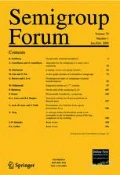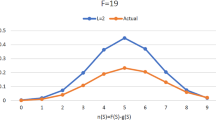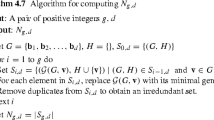Abstract
We give an asymptotic estimate of the number of numerical semigroups of a given genus. In particular, if n g is the number of numerical semigroups of genus g, we prove that
where \(\varphi = \frac{1 + \sqrt{5}}{2}\) is the golden ratio and S is a constant, resolving several related conjectures concerning the growth of n g . In addition, we show that the proportion of numerical semigroups of genus g satisfying f<3m approaches 1 as g→∞, where m is the multiplicity and f is the Frobenius number.
Similar content being viewed by others
Notes
The actual conjecture was phrased in a slightly different but equivalent way.
We do not give an explicit estimate of the supremum in Conjecture 2, although such an estimate would be theoretically possible. Zhao showed in [8] that it is at least 3.78, with numerical evidence suggesting that it is not much larger than that.
Note that m(Λ)≤f(Λ)+1 for all numerical semigroups Λ. In the case that m(Λ)=f(Λ)+1, we take [m(Λ),f(Λ)] to be empty, and our analysis still carries through.
The astute reader may notice that E′(U,S) is actually independent of S. However, it is convenient to write it in this way for sake of consistency with the notation for E(U,S) and as a reminder that U is admissible as a subset of S.
See www.sagenb.org.
References
Blanco, V., Puerto, J.: Computing the number of numerical semigroups using generating functions. Preprint. arXiv:0901.1228
Bras-Amorós, M.: Fibonacci-like behavior of the number of numerical semigroups of a given genus. Semigroup Forum 76(2), 379–384 (2008)
Bras-Amorós, M.: Bounds on the number of numerical semigroups of a given genus. J. Pure Appl. Algebra 213(6), 997–1001 (2009)
Bras-Amorós, M., Bulygin, S.: Towards a better understanding of the semigroup tree. Semigroup Forum 79(3), 561–574 (2009)
Elizalde, S.: Improved bounds on the number of numerical semigroups of a given genus. J. Pure Appl. Algebra 214(10), 1862–1873 (2010)
Kaplan, N.: Counting numerical semigroups by genus and some cases of a question of Wilf. Preprint
Rosales, J.C., García-Sánchez, P.A.: Numerical Semigroups. Springer, New York (2009)
Zhao, Y.: Constructing numerical semigroups of a given genus. Semigroup Forum 80(2), 242–254 (2010)
Acknowledgements
This work was done as part of the University of Minnesota Duluth REU program, funded by the National Science Foundation (Award 0754106). The author gratefully acknowledges Nathan Kaplan, who gave many helpful suggestions for notation and the organization of the paper, and Evan O’Dorney, whose sharp reading caught several minor errors. The author would also like to thank Nathan Pflueger and Maria Monks for advising during the research stage. Finally, the author would like to thank Joseph Gallian for organizing the Duluth REU program as well as providing various forms of support and advice along the way.
Author information
Authors and Affiliations
Corresponding author
Additional information
Communicated by Fernando Torres.
Appendix
Appendix
We fill in here some of the computational details of the proofs of Lemmas 18 and 19. The matrix calculations of this section were done using Sage.Footnote 5 Recall that in the proof of Lemma 18 we made the definition
We now justify in detail the claim that W n ≤3×1.6182n−2. Note that by explicit computation,

By the Cayley-Hamilton theorem, we obtain the recurrence
for n≥1. Thus, W n+1≤2.619W n <1.6182 W n for each n≥3, and by induction, W n ≤3×1.6182n−2, as desired.
A similar claim was made in the proof of Lemma 19. In that proof, we defined
It was claimed that W n ≤(4+2φ)×1.6184n−4. As before, we first verify this for small values of n.

We will prove by induction that W n+1≤6.8W n for all n≥1. This can be seen by direct verification for n≤4. Proceeding inductively, for n>4, we have by the Cayley-Hamilton theorem,

where we have used implicitly the basic inequalities W k ≥0 and W k+1≥W k for all k≥1. Noting that 1.6184>6.8, it is now immediate that W n ≤(4+2φ)×1.6184n−4 for all n≥1.
Rights and permissions
About this article
Cite this article
Zhai, A. Fibonacci-like growth of numerical semigroups of a given genus. Semigroup Forum 86, 634–662 (2013). https://doi.org/10.1007/s00233-012-9456-5
Received:
Accepted:
Published:
Issue Date:
DOI: https://doi.org/10.1007/s00233-012-9456-5




